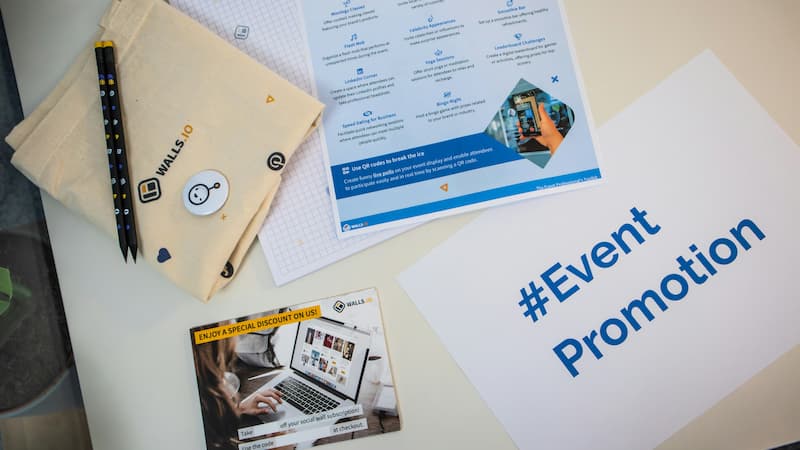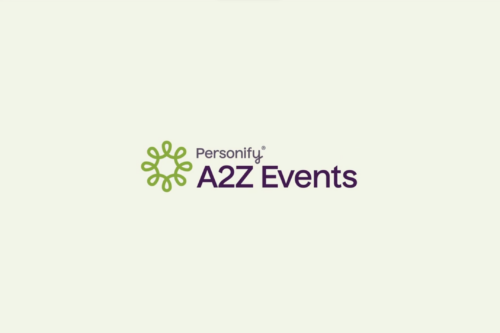Successful events don’t sell out on their own. To fill the seats with people, and the right kind of people, requires event promotion. Here are 16 ideas for driving more traffic to your event.
What Is Event Promotion?
Event promotion is the use of marketing strategies and marketing channels to spread the word about your event, engage your target audience and drive interest in and attendance at the event. If you attract a full roster of the right kind of attendees, your event will generate conversation and chatter, not only before and during your sessions but also continuing into the future.
Effectively promoting events raises awareness of your offering and entices potential attendees. It will maximize pre-event registrations. To capture as many attendees as possible, you need to understand your audience, including their needs and preferences. You must show them the benefits of choosing what you have to offer. You’ll need strategies that make full use of the channels available to you, including social media, your website, email and even word of mouth.
If you have a sponsor with deep pockets, you might launch a major campaign using traditional media such as print and TV. If your budget is limited, however, there are many cost-effective routes to successfully promoting an event.
Start By Defining Your Event Promotion Goals
Before you start posting on social media and sending emails, stop and think about what you hope to accomplish. One thing everyone aims for is to have a lot of people in attendance. You should have a goal for total registrations and total actual attendees. You may have a revenue goal that considers discounted registrations and free registrations.
However, you don’t want to fill seats with just anyone. You need the right kind of people in those seats. You might segment your attendance goal by industry and by job description.
Another thing to consider is your financial goals. Do you want your event to make money, is break-even acceptable or are you willing to spend money to expand your influence and promote your brand? If it’s brand promotion, what can you measure after the event to see how well you achieved it?
Financial goals will drive what discounts you might offer and how far you are willing to go to attract the attendees you want.
Event Promotion Ideas
With your event on the calendar and your goals established, it’s time to start rolling out marketing efforts. Here are 16 ideas to consider when designing your event promotion campaign.
1. Feature Exclusive Offers at Your Event
You can offer your attendees incentives to register as well as freebies and discounts once they arrive. After all, everybody loves a good deal. “Early bird” specials can offer reduced admission pricing before a specified deadline.
You might also limit the number of early bird tickets to generate some FOMO. And you could draw a few names of early registrants for a free admission.
You can stimulate interest by offering free merchandise for those who register early or arrive early. Let it be known that you will be providing discounts to local attractions; they’ll usually partner with you on this.
Once attendees are there, offer an extra-special deal on next year’s event. Provide a discount on your product or services that’s available only during the event.
2. Ask Participants to Share Ideas
You may have your agenda mostly set, but that doesn’t mean you can’t tweak it with suggestions from your target audience. Use surveys to see which of your proposed sessions draw the most (and least) interest.
Allow the opportunity for advance questions for your Q&A sessions. Allow future participants to suggest breakout sessions and even to volunteer to help lead them.
Be sure to let everyone know when you’ve modified the agenda based on feedback. After all, who knows more about what they want than the attendees?
3. Leverage Event Hashtags
Select a hashtag that’s unique to your event. Use it consistently on all social media communication. Add a couple of commonly used industry hashtags as complementary hashtags.
This creates consistency and brands your event. It helps your audience find all your posts across media. It establishes event credibility; it’s something most people expect to see these days.
Your hashtag can also keep your visibility high during and after the event. Encourage participants to use it on their social media accounts. You might even offer an incentive for those who forward posts with your hashtag.
4. Maximize Social Media Exposure
A lot of people use only one or two social media platforms and tend not to look at the others. Don’t wait for your social audience to come to you, but go out to meet them where they are. In particular, don’t expect everyone to visit your company or event website.
Create an event on LinkedIn, Facebook and other platforms, and link that to your site. In fact, you should have a page on Facebook and possibly elsewhere that’s dedicated specifically to your event.
Leverage many or most of your posts with a call-to-action link.
5. Work with Industry Influencers
Some people will act on what you tell them, but more will act based on the say-so of influencers. Influencers have a breadth of audience far greater than what you can reach on your own. If you know influencers who align with your event topic, contact them about marketing partnerships.
A lot of times, your speakers or panel members are influencers, and they have a stake in the success of your event. It’s likely that someone in your business network knows an influencer who can be of value to you.
You might give your influencers promo codes to share with their followers. You can offer incentives to influencers who bring in the most registrants.
6. Run Contests and Giveaways
Free ticket giveaways are one form of contest, and you don’t have to give out more than one or a few to get people interested. You can have more sophisticated entry rules than just signing up. For example, you could require that they forward/share something or tag X number of friends.
A caveat: many social media platforms have regulations around contests on their platforms; be sure to heed hem.
You might also offer free or discounted goods and services to attendees at the event itself.
7. Encourage User-generated Content
Many of your attendees have something to say about your topic that’s of interest to the entire audience. A simple way to garner this valuable information is to solicit comments on your event posts. You could invite them to provide links to on-topic materials they have already written as well as freeform commentary.
This generates interest in your event and topic among not only the contributors but also those who read the contributions.
8. Create Compelling Graphics
If you want to communicate something quickly and clearly, graphics often speak more effectively than words. Your promotional materials, both print and online, will snag more eyes when they summarize your event in a simple and visually pleasing manner.
Infographics are particularly valuable because they cost little to create and are easy to share. Many people are more willing to look at a graphic and will digest the message from pictures more readily than from words.
9. Build an Event Community
Give your new registrants the tools they can use to share with their networks. For example, generate referral links for them. Keep in touch with these future attendees using frequent updates and offerings that may be of interest to them. Invite them to join a social media group dedicated either to the event or to an event topic. Reward registrants who refer others that sign up.
10. Run Ads and Remarket
Running generic event advertising, even when it is somewhat targeted, is a scattershot approach with a limited conversion rate. However, retargeting ads are much more effective. These are messages to those who visited your website or otherwise indicated interest but did not register.
These can be Facebook retargets or Google AdWords retargeting. A lot of people put off signing up and can forget about doing so. They may act, however, if they are reminded.
11. Leverage Blogs, Podcasts and Videos
Someone who is reading your blog or listening to your podcast might be interested in your event if only they knew about it. A CTA in a blog or a verbal plug at the end of podcast can let them know. If you have an audience for videos, the possibilities for promoting your event are endless.
You can shoot a video with footage of the previous event, or with a behind-the-scenes peek at organizing this year’s event. Last year’s attendees can tell the camera how valuable the event was. Quotes from this year’s speakers show the audience some of what they will get.
Keep videos short so that viewers will stick around until the end, and feature them on posts, in email links and on your website.
12. Promote Events in Your Email Signature
There are tools and templates that allow you to set up an automatic email signature for your entire team. Every email can then include an image, a link to registration and a brief description of the event.
13. Strengthen Your Event Website’s SEO
If you do this well enough, your website will appear closer to the top of the search engine results page. Make sure the URL, title tags, meta description and image alt texts contain the top keywords for your topic. Consider one or two long-tail keywords. A strongly optimized website will not only drive traffic during registration but also during and after the event.
While you’re at it, make sure your site is mobile-friendly. Many people seldom use anything larger than a phone.
14. Partner with Sponsors and Speakers
It’s likely that your sponsors, speakers, moderators and panel members have a followership as large or larger than yours. At the very least, they will have a reach into audiences that you have not penetrated.
They want to see your event succeed, so most of them will be willing to promote your event. They can use materials you provide them or promote as they see fit.
15. Use QR Codes
QR codes are ubiquitous, and everybody is accustomed to scanning them. As a result, they are becoming more prevalent in event management. You can use them on anything from printed materials to billboards.
They can link to agendas, registration forms, event details or anything else you want people to know. It’s a great way to provide promotional material that can be continually updated and never grows obsolete.
16. Spread the Word by Mouth
If you want to invite someone to a party, you can snail mail or email an invitation or use a Facebook invite. However, most people find it nice to be asked face to face. It’s an indication that your presence will truly be valued.
Task your customer-facing personnel, such as the sales force and the customer service staff, with extending an invitation in many or most of their interactions. You’ll have to put some parameters around this so people don’t tire of being asked.
Encourage your speakers, panelists and other vendors (if any) to get in on this as well. In fact, an invitation is likely to be even better received coming from them.
KPI’s
You’ll want some hard KPI’s to evaluate the success of your event. You should have established these up front in the goal-setting phase, and what you need to do after the event is gather and analyze the numbers.
For example, how many registrations were there? How many registrants actually showed up and how many did not? What was the total ticket revenue? What was the attendance at the various presentations and breakouts? How many stayed for the entire event? How many attended, broken down by industry and by job description? How much money did the event earn or cost after expenses?
During the event, social media activity is a good measure of interest. You might ask the participants to use an event hashtag and track how many times it gets used across the various platforms.
End-of-event or post-event surveys are a valuable tool for gauging event success. You can survey the attendees, the sponsors and the speakers and panelists. If surveys are short and to the point, more people will complete them. These can include questions that are amenable to net promoter score (NPS) as well as open questions for subjective evaluation.
Finally, post-event activity is another indicator of event success. Are the more website hits or increased sales? Are there more customer inquiries?
Conclusion
The difference between a so-so event and one that’s resoundingly successful is often how well it’s promoted. Effective event promotion builds anticipation and increases attendance, but the benefits don’t stop there.
Successful promotion enhances the actual event experience. It lets people know what to expect so that they come prepared. It gives registrants the opportunity to provide feedback, make suggestions and engage with you and with each other around the event theme. It helps build a community among those who will be in attendance.
A successfully promoted event yields benefits that continue even after the participants pack up and go home. A memorable event grows brand exposure and interest. It should result in more customer interactions and more sales. Most of the ideas for brand promotion are not rocket science, but they can produces results that far exceed the effort it takes to put them in place.










